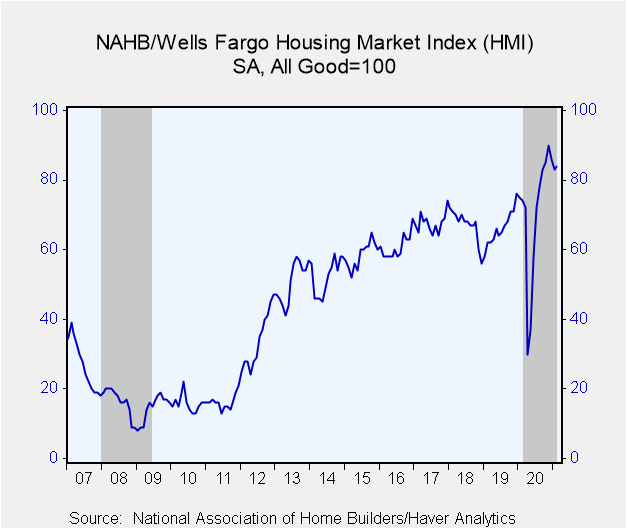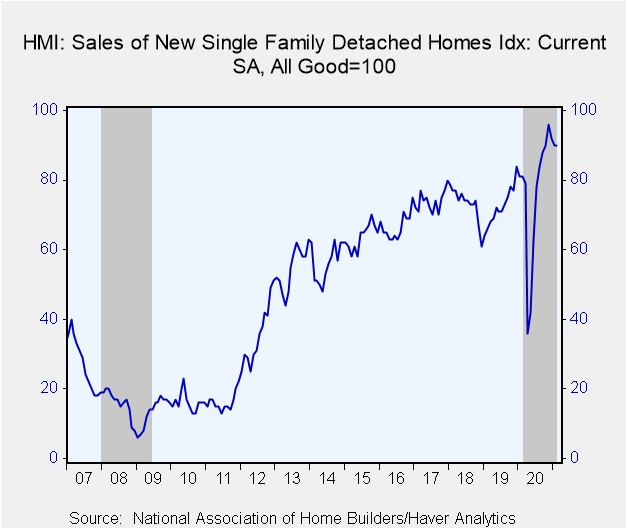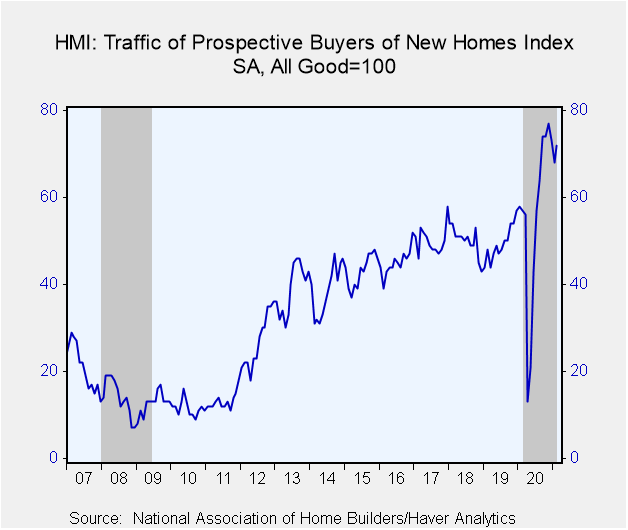 Global| Feb 17 2021
Global| Feb 17 2021U.S. Home Builder Index Edges Higher During February
by:Tom Moeller
|in:Economy in Brief
Summary
• Housing market activity remains below earlier high. • Improvement in the Northeast accompanies mixed performance elsewhere. The Composite Housing Market Index from the National Association of Home Builders-Wells Fargo improved 1.2% [...]
• Housing market activity remains below earlier high.
• Improvement in the Northeast accompanies mixed performance elsewhere.
The Composite Housing Market Index from the National Association of Home Builders-Wells Fargo improved 1.2% (13.5% y/y) to 84 during February following January's 3.5% decline and December's 4.4% drop. The index reached a record of 90 in November. The February decline compared to expectations for an unchanged reading of 83 in the INFORMA Global Markets survey. The NAHB figures are seasonally adjusted. Over the past 15 years, there has been a 70% correlation between the y/y change in the home builders index and the y/y change in new plus existing home sales.
Performance amongst the composite index's three components was mixed this month. The index of present sales conditions held steady at 90 in February following two months of decline. The index remained 11.1% higher than one year ago. The index of expected sales six months declined 3.6% in February (1.3% y/y) to 80, the third consecutive month of decline. The index measuring traffic of prospective buyers increased 5.9% (26.3% y/y) to 72 this month following declines during the prior two months.
Regional index performance also varied in February. The index for the Northeast strengthened 30.9% (34.8% y/y) after falling sharply in each of the prior three months. The index for the Midwest rose 1.2% (28.6% y/y) following declines in the prior two months. The index for the South held steady (3.8% y/y) after falling in three of the prior four months. The index for the West eased 1.1% (+11.0% y/y), the third consecutive monthly decline. These regional series begin in December 2004.
The NAHB has compiled the Housing Market Index since 1985. It reflects survey questions which ask builders to rate sales and sales expectations as "good," "fair" or "poor" and traffic as "very high," "average" or "very low." The figures are diffusion indexes with values over 50 indicating a predominance of "good"/"very high" readings. In constructing the composite index, the weights assigned to the individual index components are: 0.5920 for single-family detached sales, present time, 0.1358 for single-family detached sales, next six months, and 0.2722 for traffic of prospective buyers. These data are included in Haver's SURVEYS database.
| National Association of Home Builders | Feb | Jan | Dec | Feb'20 | 2020 | 2019 | 2018 |
|---|---|---|---|---|---|---|---|
| Composite Housing Market Index, SA (All Good=100) | 84 | 83 | 86 | 74 | 70 | 66 | 67 |
| Single-Family Sales: Present | 90 | 90 | 92 | 81 | 76 | 72 | 73 |
| Single-Family Sales: Next Six Months | 80 | 83 | 85 | 79 | 74 | 72 | 74 |
| Traffic of Prospective Buyers | 72 | 68 | 73 | 57 | 56 | 49 | 50 |
Tom Moeller
AuthorMore in Author Profile »Prior to joining Haver Analytics in 2000, Mr. Moeller worked as the Economist at Chancellor Capital Management from 1985 to 1999. There, he developed comprehensive economic forecasts and interpreted economic data for equity and fixed income portfolio managers. Also at Chancellor, Mr. Moeller worked as an equity analyst and was responsible for researching and rating companies in the economically sensitive automobile and housing industries for investment in Chancellor’s equity portfolio. Prior to joining Chancellor, Mr. Moeller was an Economist at Citibank from 1979 to 1984. He also analyzed pricing behavior in the metals industry for the Council on Wage and Price Stability in Washington, D.C. In 1999, Mr. Moeller received the award for most accurate forecast from the Forecasters' Club of New York. From 1990 to 1992 he was President of the New York Association for Business Economists. Mr. Moeller earned an M.B.A. in Finance from Fordham University, where he graduated in 1987. He holds a Bachelor of Arts in Economics from George Washington University.










